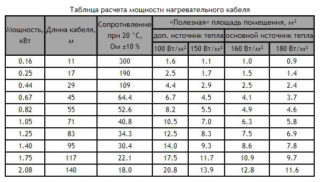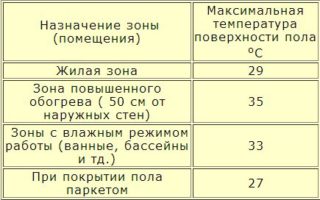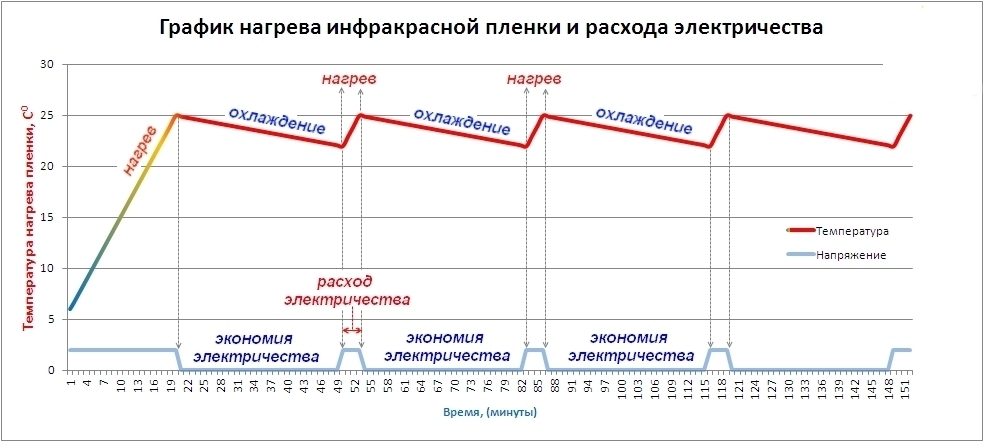Underfloor heating is one of the ways to heat an apartment. Radiators do not warm up the lower part of the apartment, therefore, to create a comfortable temperature, you need to make a separate system. Before installing the heating system, you need to calculate in advance the electricity consumption of a warm floor per 1 m2 and choose the best offer. The wrong choice threatens with unnecessary costs and inefficiency of heating.
Types of floor heating systems
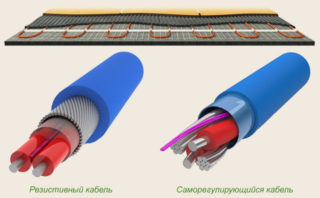
Underfloor heating systems differ in their design, characteristics and energy consumption.
Resistive heating cable
The design that runs on resistive heating cables is simple and inexpensive. The basis is a one- or two-core wire with a certain resistance. The outer shell is a protective shield. The wire has a fixed length, which must remain the same.
It fits into a screed with a thickness of about 5 cm. It is not recommended to make it thicker, as heat loss will increase. The power of the cable is low, it can be increased up to 200 W / m2. The heat is distributed evenly over the entire surface.
Self-regulating heating cable
Compared to mats and resistive cables, self-regulating cables differ in the dependence of the linear power on the temperature. It does not require permanent heat dissipation, which can disrupt the operation of the resistive cable. A semiconducting polymer acts as a heating element, which changes its resistance depending on temperature. These cables can be cut anywhere, as overheating is independent of length. Specific power 120-150, W / sq.m.
Heating mats

Already have a heating cable in the design. The standard width of the mat is 45 cm, the length may vary. It is forbidden to cut the products, since they are based on a heating element.
Main characteristics:
- The voltage is usually 220-230 V.
- Length from 1 to 24 m.
- The recommended laying area is usually 0.5 to 12 square meters.
- Specific power is on average 100-150 W / sq.m. Less commonly, they are produced with a specific power of 200 W / m2.
The main advantage of mats is ease of installation and calculation.
Film infrared floor
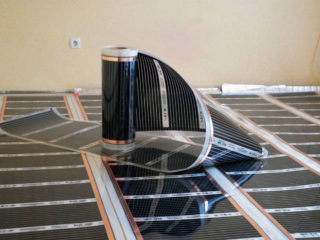
Infrared floors are a fairly new form of heating. The structure contains emitters made in the form of graphite strips. They are connected to copper wires. The whole system is placed on a polyester film up to 0.4 mm thick. An important difference from other types of floors is radiant energy. It is aimed at heating not the floor itself, but the objects that are located on it. This is well felt by humans, which is why IR floors are among the most comfortable.
The power of the film underfloor heating is 110-220 W / m2.
The width of the rolls is different - there are floors of 50 cm, 80 cm and 1 m.The length is from 1 m to 20 m.
Rod infrared underfloor heating
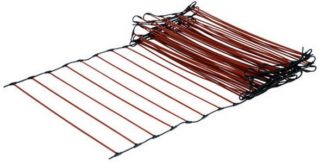
The most modern solution in floor heating is a rod IR floor. The heater is a flexible element made of carbonate, graphite and silver. The main property that distinguishes the core floor from others is the drop in power consumption at temperatures from +20 to +60 degrees.Thanks to this, the floors can be laid even in the places where furniture is located, which will be periodically rearranged.
The power of the core floor is 70-160 W / m2. The efficiency reaches 95%.
Energy consumption calculation
What you need to know for calculations:
- heated area (70-80% recommended);
- floor covering characteristics;
- quality of walls and floors;
- the ability of the wiring to withstand the load.
IR rod floors can be installed over the entire surface, including under furniture.
General heating is recommended with resistive cables, and for comfort - with heating mats or infrared floors.
To determine the heating efficiency, use the formula P = S * k, where P is the floor power, S is the area to be heated, K is the specific power.
The power density is different for each room. For living rooms and kitchens on the 1st floor, it is 140-150 W / sqm, on the 2nd floor and above 110-120 W / sqm.
For balconies and loggias with insulation, the specific power is 140-180 W / m2. Bathroom on the 1st floor - 120-150 W / sqm, on the 2nd floor and above - 110-130 W / sqm.
If the floor is used as the main heating, the power density must be at least 180 W / m2. For additional heating, 110-120 W / m2 is sufficient.
Calculation example
You need to be able to calculate electricity consumption - the amount of monthly payment for electricity directly depends on this value.
The calculation was made for a room with an area of 20 square meters, heated with a capacity of 14 square meters and a floor operating time of 6 hours a day. Specific power 150 W / sq.m. Then the power consumption is 150 * 14 = 2100 W. The monthly rate is 6 * 2100 * 30 = 37800 W / h or 378 kW / h. This value is then multiplied by the regional cost of 1 kW.
Features of the calculation of IR structures
When choosing and calculating film floors, you need to take into account a number of features. First of all, they should fit on a surface free of furniture. Secondly, the minimum distance to the wall or furniture should be 20 cm. Installation only "dry". It should also be borne in mind that installation and calculation depend on all electrical connections located below the surface.
Recommendations for choosing film systems:
- additional heating requires 120-150, W / sq.m .;
- for the main 170-220 W / sq.m.
Calculation algorithm:
- Calculation of the heated area.
- Calculation of the fraction of the heated power. It is necessary to multiply the heated area by 100% and divide by the total area of the room. With an indicator of more than 60%, the specific power of the film should be from 160 to 220 W / m2. If the proportion is less than 60%, the specific power is 220 W / m2.
- Consideration of large heat losses. If the room is located on the ground floor, above an arch or in an old building without thermal insulation, the specific power should be 220 W / m2.
- Calculation of the installed capacity. The specific power is multiplied by the area to be heated.
Based on the calculated data, a suitable IR film is selected. Better to take in small pieces for proper installation. Each segment must have its own thermostat.
Rod infrared floors can be installed over the entire surface of the room. You need to choose additional components and a thermostat. Wood and thin coatings are best installed using thermostats with two temperature sensors (floor and air surfaces).
When creating heating systems, it must be borne in mind that not all coatings can be used.You can not put underfloor heating under rubber-based linoleum, thick carpets, plank floors with a thickness of more than 0.25 cm. When buying a covering, it is imperative to clarify whether they are compatible with the heating system. This can be understood by the special icon on the packaging and in the documentation.
Cost reduction tips
It is possible to reduce energy costs, for this it is worth using the following recommendations:
- Using a thermostat. You can save up to 40% energy.
- Reducing heat loss. It is recommended to insulate the walls - this will allow you to consume less electricity by 2 times.
- Installation of a multi-tariff system. At night, electricity consumption is 1.5-2 times less. The value depends on the region.
- Make the necessary indents and do not place electric heaters under furniture.
In advance, you should calculate the entire system and the required power of the electric underfloor heating for 1 m2. Calculations can be made in special online calculators.

